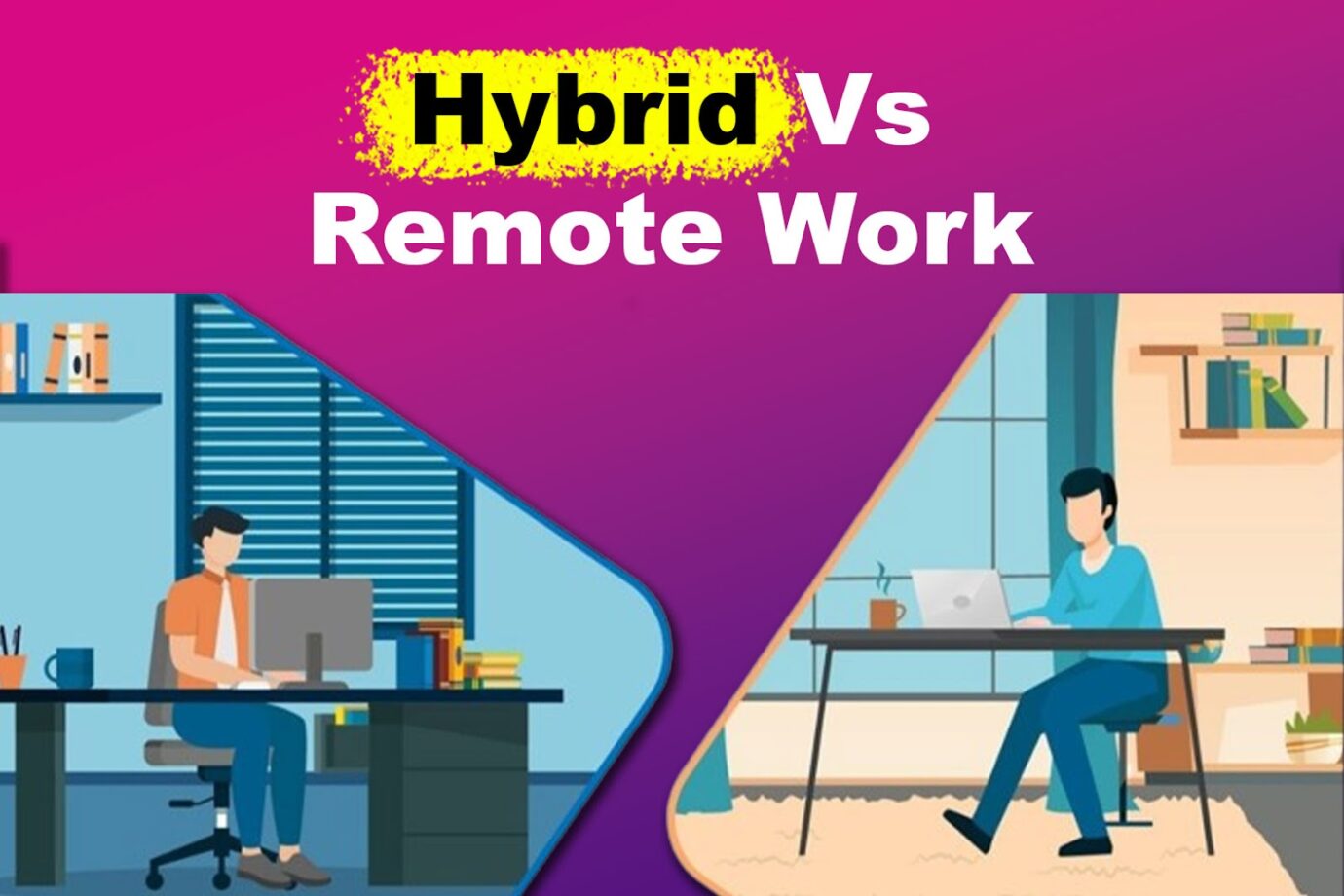The debate between hybrid and remote work has become popular among employees seeking a better work model. As an employee, it is important to understand the differences and how they can affect your productivity and well-being.
Keep reading to understand what hybrid and remote work means so you can make an informed decision that suits your work preferences and lifestyle.

What is Hybrid Work?
Hybrid work is a flexible arrangement that allows employees to work in the physical office or remotely, whether at home or in another location. This setup enables employees to split their time between remote work and working in a traditional office.
In this setup, employees can choose to work from home or attend in-person meetings with an agreement from the company. Some hybrid work arrangements allow employees to work remotely on specific days of the week.
It is important to note that various factors can influence a company’s hybrid work policy. These include both workers’ choices and the needs of the work.
This LinkedIn article answers why hybrid work is a more efficient and preferred choice for businesses that want to offer more flexibility to their employees.
What Is Remote Work?

Remote work is a work arrangement that allows employees to work from a location outside of a traditional office environment. In this arrangement, employees can work from anywhere as long as they can access the Internet.
Instead of physically commuting to an office, remote workers rely on technology, digital tools, and software to complete their job responsibilities. These tools enable them to collaborate with colleagues, participate in meetings, and complete their jobs remotely.
Is remote work going away? Upwork predicts that by 2026, almost half of the workforce will partially or completely work remotely.
What Is the Difference Between Remote and Hybrid Work?
The main difference between fully remote and hybrid work is the flexibility in where and how employees perform their duties. However, they also differ in other aspects.
Here are the differences between remote and hybrid work:
1. Work Setting
Hybrid Work
In a hybrid work environment, employees usually divide their time between remote work and working in a traditional office space. Hybrid workers usually split a week and plan certain days to work in the office or home.
Remote Work
Remote work typically comprises employees working completely in places other than the office on a full-time basis. They possess greater autonomy regarding their environment and daily schedule.
Is remote work going away? Find out here.
2. Workspace Flexibility

Hybrid Work
Hybrid work setups offer flexibility by allowing employees to experience the benefits of working in an office. This model creates opportunities for in-person interaction and teamwork in an office setting.
Looking for a remote work? Our list of remote jobs that pay well may help you land a good job!
Remote Work
Working remotely offers more flexibility in selecting where an employee can work. It doesn’t matter where they work as long as they have the necessary equipment to communicate and finish their tasks. They also do not have to go to a physical office at all.
3. Communication and Collaboration
Hybrid Work
Hybrid work uses a combination of face-to-face meetings and virtual communication. This arrangement creates additional opportunities for teamwork or conversations, particularly in in-person meetings.
However, although hybrid workers may have more opportunities for collaboration, they may face difficulties feeling equally engaged and active in team activities and decision-making processes.
Remote Work
Remote work relies solely on virtual communication platforms such as videoconferencing, email, and instant messaging.
In terms of collaboration, remote workers may need to intentionally establish connections and maintain teamwork by participating in virtual team-building activities.
Find out the ideal hybrid work schedule here!
What Do Hybrid and Remote Work Have in Common?
Hybrid and remote work have similarities in flexibility, reliance on technology, independence, and a focus on results. These similarities make these work setup suitable for environments that aim to meet the modern workforce’s evolving needs, which often prioritize work-life balance.
Both hybrid and remote work offer the flexibility to choose where employees work, whether from their homes or co-working spaces. The crucial factor is that employees have access to the internet.
Both models rely on a stable internet connection to utilize digital communication tools, such as email and videoconferencing, for collaboration.
Both models allow employees to work independently, leading to higher job satisfaction. They also promote a work culture that prioritizes productivity, as employee performance is evaluated based on results and outcomes.
Ever heard of hybrid-remote work? Find out its definition, differences, and risks here.
Pros and Cons of the Remote Work Model
As remote work becomes more prevalent in modern workplaces, its advantages and disadvantages must be considered. While it may seem like the ideal work environment, employers and employees must weigh the pros and cons of remote work to see if it’s a good fit.
Pros of the Remote Work Model
Here are the benefits of remote work:
-
More Freedom.
Remote work gives employees the freedom to choose their own work hours and location, allowing for a better work-life balance.
- No More Commuting.
With remote work, there is no need to travel to a physical office, which saves time and money on transportation and reduces the stress of daily commuting. - Improved Efficiency.
Many remote workers find they are more productive because they have fewer distractions and interruptions compared to a traditional office environment.
ConnectSolutions reported that 77% of individuals who work remotely a few times a month display enhanced productivity. This is according to an article on LinkedIn. - Global Talent Pool.
Remote work allows companies to tap into a global talent pool, as geographical location is no longer a barrier to hiring. This creates more opportunities for both employers and employees. - Cost-Effective.
Remote work is cost-effective for companies and employees, saving money on office space, overhead, and commuting expenses.
Check out these easy to get remote jobs!
The Cons of Remote Work
Here are the drawbacks of remote work:
-
Isolation and Loneliness
Remote work can cause loneliness, especially for individuals who thrive on socializing in a traditional office setting.
- Difficulty in Communication and Collaboration.
Remote work can make communication and collaboration more challenging, as digital tools may not always be as effective as face-to-face interactions. - Challenges in Maintaining Work-Life Balance.
Remote workers may have difficulty maintaining a work-life balance without clear boundaries, which can lead to burnout and decreased well-being. - Security Risks.
Working remotely presents different security risks because sensitive data is accessed outside the usual office setting. As a result, increased security measures may be needed. - Limited Opportunities for Career Growth.
Remote workers may have fewer career growth opportunities than office-based employees, as visibility within the company is often preferred for promotions.
Are you an employer? Check out this LinkedIn article to determine if fully remote or hybrid work is the best work model for your company.
Pros and Cons of the Hybrid Work Model
Like remote work, hybrid work has benefits and drawbacks. It is one of the most popular and efficient work models in the modern workplace, yet it also brings difficulties, such as possible communication problems.
Pros of Hybrid Work
Here are the benefits of hybrid work:
-
More Flexible.
Hybrid workers can split their time between remote and in-office work, allowing them to create schedules that work for them.
- Better Work-Life Balance.
Hybrid work can lead to a better work-life balance, higher job satisfaction, and lower burnout rates by reducing the need for daily commutes and giving employees more control over their work hours. - In-Person Collaboration.
Hybrid workers have the opportunity to collaborate and interact with colleagues face-to-face, which can help strengthen relationships. - Reduced Commuting Stress.
Hybrid work can reduce commuting stress and save employees time and money by decreasing the days they must commute to the office.
Cons of Hybrid Work
Here are the drawbacks of hybrid work:
- Logistic Challenges.
Managers and team leaders can find it challenging logistically to plan and coordinate with hybrid workers, including managing schedules and coordinating meetings. - Potential for Disconnection.
Hybrid work can make remote employees feel disconnected or isolated, as interacting and forming social bonds in person may be more difficult. -
Unequal Opportunities.
Some employees may feel disadvantaged or overlooked in hybrid work setups, leading to discrepancies in career advancement and opportunities for professional growth based on their preferences and job roles.
- Weak Workplace Relationship.
When a hybrid employee spends more time working from home, there are fewer opportunities for social interactions, making it more challenging to establish or strengthen relationships with coworkers.
Read more about the advantages and disadvantages of hybrid work in this article from LinkedIn.
Discover the challenges and solutions of hybrid working in this article.
Which Is Better: Hybrid or Remote Work?
When choosing between hybrid and remote work, consider your personal preferences, work style, and job demands. Also important is considering what will be most effective for your productivity, teamwork, and overall health.
Both options vary in terms of their level of flexibility, so it’s important to choose wisely.
Ultimately, deciding to work in a hybrid or remote setting is completely in your hands. Consider both perspectives and evaluate what you believe is the most helpful option for yourself.



